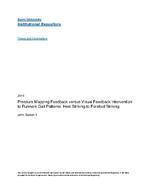|
|

Notes
- Abstract:
- To maintain good physical health, more people have performed the sport of running. This has shown improvements in cardiovascular and respiratory health. However, the side effects of running are musculoskeletal injuries. These injuries arise due to high ground force reaction and poor running mechanics. Literature has shown that running in a forefoot strike pattern has reduced peak ground reaction forces (Lieberman et al., 2010). The transition into a new running gait pattern cannot be done without an intervention. In this study, an intervention was constructed to test two different augmented feedback protocols to reduce ground reaction force and to develop a new strike pattern. METHODS: Participants (n =12) were randomly selected into two feedback groups (video and plantar pressure mapping). F-Scan 300 sensors were used to measure peak forces during running. A flatscreen LED Television was utilized at the focus of attention of the two feedback protocols. A 2D high-speed Vicon Bonita camera was positioned in the sagittal plane. Participants trained for 3 weeks and twice a week, for a total of 6 training periods. Data was collected on the first day of training (Day One trial) and the day after with no feedback training (Post-Test). RESULTS: No significant difference (p > 0.05) was found in reduction of peak ground reaction force between and within groups. All participants developed a forefoot strike pattern. CONCLUSION: There was no interaction or main effects in reducing ground reaction forces between feedback groups and time. The feedback protocol helped participants adjust to a new gait pattern however ground reaction force values did not reduce. Other methods of research are needed to reduce running force.
- Thesis:
- Thesis (M.S.)--Barry University, 2015.
- Bibliography:
- Includes bibliographical references (leaves 38-43).
Record Information
- Source Institution:
- Barry University
- Holding Location:
- Barry University Archives and Special Collections
- Rights Management:
- Copyright John Saxton. Permission granted to Barry University to digitize, archive and distribute this item for non-profit research and educational purposes. Any reuse of this item in excess of fair use or other copyright exemptions requires permission of the copyright holder.
- Resource Identifier:
- RC1220.R8 S38 2015_SaxtonJohn ( BU-Local )
- Classification:
- RC1220.R8 S38 2015 ( lcc )
|
|